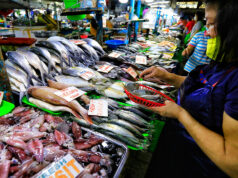Economic managers pitch PHL opportunities to investors in Singapore
ECONOMIC MANAGERS of President Rodrigo R. Duterte flew to Singapore this week to woo more foreign firms to invest in the Philippines, branding the country as Asia’s “next economic powerhouse” with fresh opportunities for growth, particularly in infrastructure.
Finance Secretary Carlos G. Dominguez III, Socioeconomic Planning Secretary Ernesto M. Pernia and Budget Secretary Benjamin E. Diokno, as well as Bangko Sentral ng Pilipinas (BSP) Governor Nestor A. Espenilla, Jr. made the case before a group of investors in Singapore on Tuesday, the government’s Investor Relations Office (IRO) said.
Executive Secretary Salvador C. Medialdea also joined the team of technocrats.
The top Philippine officials assured the foreign business community that gross domestic product (GDP) growth will remain on an upward trend, approaching or hitting the 7-8% annual target set by the government over the next five years compared to 2010-2015’s 6.2% average.
The Cabinet members specifically pitched the P8.44-trillion ($170 billion) infrastructure spending plan as the biggest pocket of opportunities for businesses to cash in.
“Upgrading infrastructure is seen to boost economic productivity and enhance connectivity that will cut down the cost of doing business,” Mr. Diokno said in a separate statement yesterday, describing the “Build, Build, Build” blueprint as the “boldest” plan that the country has ever laid out.
Having more investments in the Philippines spells additional jobs and capital to support business expansion and opportunities for locals.
FUND RELEASES ‘ON THE DOT’
Mr. Diokno also allayed fears of slow disbursements and low absorptive capacity among state agencies, noting that underspending has been trimmed to 3.6% of the total budget versus 12.8% in 2015.
For the first semester, fund releases have been “practically on the dot,” the Budget chief said.
Apart from infrastructure, gains made via higher spending on social services and stronger household spending should help fuel economic growth momentum, alongside increased factory output, real estate and other construction activities, wholesale and retail trade, tourism and business process outsourcing sales, the IRO said.
Such support is expected to keep the Philippines in the ranks of Asia’s fastest-growing economies and will bring the country to upper-middle-income status by 2022, as targeted by the current administration.
For his part, the central bank’s Mr. Espenilla said that the Philippines can “sustain high growth supported by sound macroeconomic management” and can withstand global volatilities with its “domestic sources of resilience.”
The current administration targets robust economic growth that will in turn translate to lower poverty and unemployment rates among Filipinos by 2022, when Mr. Duterte ends his six-year term.
The government hopes to trim by 2022 the poverty incidence to 14% from 21.6% in 2015 and unemployment rate to 3-5% from 5.5% last year. — Melissa Luz T. Lopez



